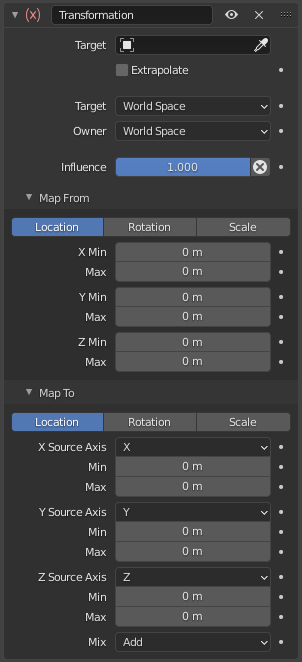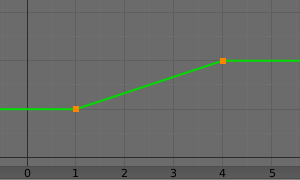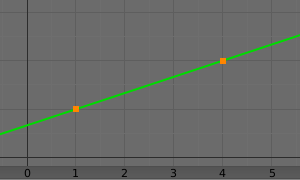La contrainte Transformation
This constraint is more complex and versatile than the other « transform » constraints. It allows you to map one type of transform properties (i.e. location, rotation or scale) of the target, to the same or another type of transform properties of the owner, within a given range of values (which might be different for each target and owner property). You can also switch between axes, and use the range values not as limits, but rather as « markers » to define a mapping between input (target) and output (owner) values.
So, e.g. you can use the position of the target along the X axis to control the rotation of the owner around the Z axis, stating that 1 unit along the target X axis corresponds to 10 units around the owner Z axis. Typical uses for this include gears (see note below), and rotation based on location setups.
Options

Le panneau de Transformation.
- Cible
L'Identifiant de données (Data ID) utilisé pour sélectionner la cible des contraintes, et n’est pas fonctionnel (état rouge) lorsqu’il n’en a pas. Voir common constraint properties pour plus d’informations.
- Extrapolate
By default, the Min and Max values bound the input and output values; all values outside these ranges are clipped to them. When you enable this button, the Min and Max values are no longer strict limits, but rather « markers » defining a proportional (linear) mapping between input and corresponding output values. Let us illustrate that with two graphs Fig. The Extrapolate principles.. In these pictures, the input range (in abscissa) is set to (1.0 to 4.0), and its corresponding output range (in ordinate), to (1.0 to 2.0). The yellow curve represents the mapping between input and output.
The Extrapolate principles. 
Extrapolate disabled: the output values are bounded inside the (1.0 to 2.0) range.

Extrapolate enabled: the output values are « free » to proportionally follow the input ones.
- Target/Owner
Conversion standard entre les espaces. Voir propriétés des contraintes communes pour plus d’informations.
- Influence
Contrôle le pourcentage d’effet de la contrainte sur l’objet. Voir Propriétés de contrainte communes pour plus d’informations.
Map From
It contains the input (from target) settings.
- Location, Rotation, Scale
The radio buttons allow you to select which type of property to use.
- Mode (Rotation)
Allows specifying the type of rotation input to use, including different Euler orders, Quaternion, and other Rotation Channel Modes. Defaults to using the Euler order of the constraint owner.
In the Quaternion mode the channels are converted to weighted angles in the same way as the swing angles of the Swing and X/Y/Z Twist modes.
- X/Y/Z Min, Max
Independently for each axis (X, Y, and Z) the min and max number fields control the lower and upper bounds of the input value range. Note that if a min value is higher than its corresponding max value, the constraint behaves as if it had the same value as the max one.
Map To
It contains the output (to owner) settings.
- Location, Rotation, Scale
The three radio buttons allow you to select which type of property to control.
- Order (Rotation)
For rotation, allows specifying which Euler order to use during evaluation of the constraint. Defaults to using the order of the constraint owner.
- X/Y/Z Source Axis
The three axis selectors allow you to select which input axis to map to, respectively (from top to bottom), the X, Y and Z output (owner) axes.
- Min, Max
The Min and Max number fields control the lower and upper bounds of the output value range, independently for each mapped axis. Note that if a min value is higher than its corresponding max value, the constraint behaves as if it had the same value as the max one.
- Mix
Spécifie comment le résultat de la contrainte est combiné à la transformation existante. L’ensemble des choix disponibles varie en fonction du type de transformation.
- Replace
Le résultat de la contrainte remplace la transformation existante.
- Multiply (Scale)
Les nouvelles valeurs sont multipliées par les valeurs d’axe existantes.
- Add (Location, Rotation)
Les nouvelles valeurs sont ajoutées aux valeurs d’axe existantes.
- Before Original (Rotation)
La nouvelle rotation est ajoutée avant la rotation existante, comme si elle était appliquée à un parent du propriétaire de la contrainte.
- After Original (Rotation)
La nouvelle rotation est ajoutée après la rotation existante, comme si elle était appliquée à un enfant du propriétaire de la contrainte.
Note
Pour des raisons historiques, le mode Mix a pour valeurs par défaut Add pour la position et la rotation, et Replace pour la mise à l’échelle.
When using the rotation transform properties of the target as input, whatever the real values are, the constraint will always « take them back » into the (-180 to 180) range. E.g. if the target has a rotation of 420 degrees around its X axis, the values used as X input by the constraint will be:
\(((420 + 180) modulo 360) - 180 = 60 - ...\)
This is why this constraint is not really suited for gears!
De même, dans l’utilisation des propriétés de transformation d’échelle de la cible comme entrée, quelles que soient les valeurs réelles, la contrainte va toujours prendre leurs valeurs absolues (càd. qu’elle va inverser les valeurs négatives).
When a min value is higher than its corresponding max one, both are considered equal to the max one. This implies you cannot create « reversed » mappings…